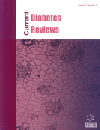- Home
- A-Z Publications
- Current Diabetes Reviews
- Previous Issues
- Volume 11, Issue 2, 2015
Current Diabetes Reviews - Volume 11, Issue 2, 2015
Volume 11, Issue 2, 2015
-
-
Is Type 2 Diabetes Mellitus a Predisposal Cause for Developing Hepatocellular Carcinoma?
More LessHepatic cancer stands as one of the frontier causes of cancer related mortality worldwide. Among the several risk factors already established, type 2 diabetes is now considered as one of the important risks in progression of liver cancer. Studies have shown that likelihood of occurrence of liver cancer is many folds higher in patients diagnosed with type II diabetes compared to patients without diabetes. Liver plays an important r Read More
-
-
-
Major Depressive Disorder and Diabetes: Does Serotonin Bridge the Gap?
More LessAuthors: Nicole E. De Long, Rebecca A. Stepita, Valerie H. Taylor and Alison C. HollowayMajor depressive disorder (MDD) is one of the most common psychiatric illnesses worldwide, with reported prevalence rates ranging between 10% and 19%. Pharmacotherapy is a first-line option for the management of MDD and, as a result, the use of antidepressants has increased 4 fold in the last 20 years. Serotonin is the most commonly dysregulated neurotransmitter in the etiology of MDD and this system is the primary focu Read More
-
-
-
Recent Advances in Management of Diabetic Macular Edema
More LessDiabetic macular edema (DME) is the leading cause of moderate vision loss in diabetics. Modalities to image and monitor DME have evolved much in the last decade. Systemic control is the most important part of management. Available ocular management options include intravitreal antivascular endothelial growth factor (anti-VEGF) agents, laser, steroids (intravitreal or peribulbar), vitrectomy, topical medications and Read More
-
-
-
Screening for Silent Coronary Artery Disease in Diabetics- or Not?
More LessThe association between diabetes mellitus and coronary artery disease (CAD) is wellknown. Being the leading cause of death in diabetics, CAD is a target for prevention, diagnosis and treatment. In that sense, silent CAD in diabetics has long been a matter of concern, leading both to continued attempts at its diagnosis as well as to the persisting challenge of defining if screening for CAD in the diabetic population is useful and/or Read More
-
-
-
A Review on Electrocardiographic Changes in Diabetic Patients
More LessAuthors: Iana Simova, Ivaylo Christov and Giovanni BortolanPrevalence of diabetes mellitus (DM) is progressively increasing, contributing to a parallel increase in cardiovascular morbidity and mortality, and more than doubling the incidence of sudden cardiac death (SCD). Certain electrocardiographic (ECG) characteristics, such as alternans of the T wave (TWA), heart rate variability (HRV) and dispersion of the QT interval, have been found to be predictive of the risk of SCD. This revie Read More
-
-
-
A Novel Antidiabetic Therapy: Free Fatty Acid Receptors as Potential Drug Target
More LessAuthors: Hiroki Sekiguchi, Mayu Kasubuchi, Sae Hasegawa, Nicolas Pelisch, Ikuo Kimura and Atsuhiko IchimuraExcessive dietary intake of fat is strongly involved in the development of type 2 diabetes (T2D). Free fatty acids (FFAs), which are provided from dietary fat, are not only important nutrients, but also act as signaling molecules and stimulate key biological functions. Recent physiological and pharmacological studies have shown that several G-protein coupled receptors, such as FFAR1–4, are receptors for FFAs. FFAR1 and FFAR Read More
-
-
-
Diagnosis and Management of Diabetes and the Relationship of dGlucose to Kidney Function
More LessAuthors: Anil K. Mandal and Linda HiebertThis article reviews different glycemic parameters and is aimed to clarify the most dependable glycemic parameter that predicts renal preservation. Glycosylated hemoglobin (HbA1c) and fasting blood glucose (FBG) are the most commonly ordered tests for the diagnosis of diabetes and are also used to indicate prevention of microvascular complications associated with diabetes. Some experts have concluded that Hb Read More
-
-
-
Predictive Factors of follow-up Non-attendance and Mortality Among Adults with Type 2 Diabetes Mellitus- an Analysis of the Malaysian Diabetes Registry 2009
More LessThis study examined the factors associated with follow-up non-attendance (FUNA) and mortality among the adult patients with type 2 diabetes mellitus (T2DM). Data on 57780 T2DM patients from the 2009 diabetes registry were analyzed using multinomial logistic mixed model. Out of 57780 patients, 3140 (5.4%) were lost to follow-up and 203 (0.4%) patients had died. Compared with patients who were under active follow-up, Read More
-
Volumes & issues
-
Volume 21 (2025)
-
Volume 20 (2024)
-
Volume 19 (2023)
-
Volume 18 (2022)
-
Volume 17 (2021)
-
Volume 16 (2020)
-
Volume 15 (2019)
-
Volume 14 (2018)
-
Volume 13 (2017)
-
Volume 12 (2016)
-
Volume 11 (2015)
-
Volume 10 (2014)
-
Volume 9 (2013)
-
Volume 8 (2012)
-
Volume 7 (2011)
-
Volume 6 (2010)
-
Volume 5 (2009)
-
Volume 4 (2008)
-
Volume 3 (2007)
-
Volume 2 (2006)
-
Volume 1 (2005)
Most Read This Month
Article
content/journals/cdr
Journal
10
5
false
en


